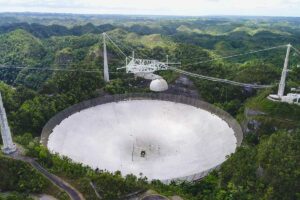Engineers Ignored Warning Signs in Arecibo Telescope Collapse
A new report from the National Academies concludes that the Arecibo radio telescope in Puerto Rico collapsed in 2020 due to failures of cable sockets that supported the platform above the dish because of accelerated zinc creep. Structural engineers who inspected the cables and sockets missed warning signs, especially after winds from Hurricane Maria placed extra stress on the cables. The authors also speculate that the electromagnetic environment may have been a contributing factor.
The report from the Academies’ Board on Infrastructure and the Constructed Environment cited a number of technical and managerial factors that led to the collapse of Arecibo’s 913-ton instrument platform on December 1, 2020, but fundamentally it was the failure of engineers to recognize the warning signs.
Arecibo was owned by the National Science Foundation (NSF) and managed by the University of Central Florida. No one was injured.
The root cause was “unprecedented and accelerated long-term zinc creep induced failure of the telescope’s cable spelter sockets” according to the Committee on the Analysis of Causes of Failure and Collapse of the 305-Meter Telescope at the Arecibo Observatory.

The committee, chaired by Roger McCarthy of McCarthy Engineering, acknowledged that the accelerated zinc creep was unprecedented, but nonetheless concluded engineers had plenty of warning that something was wrong after Hurricane Maria. Winds from the September 20, 2017 storm that topped 100 miles per hour added stress to the cables and sockets, but they should have been able to withstand it. Instead it aggravated their already weakened condition due to zinc creep and initiated a 39-month “failure sequence.”
“The Arecibo Telescope gave fair warning post-Maria that it was in structural distress through increasing cable socket pullout. Upon reflection, the unusually large and progressive cable pullouts of key structural cables that could be seen during visual inspection several months and years before the M4N failure should have raised the highest alarm level, requiring urgent action. The lack of documented concern from the contracted engineers about the inconsequentiality of cable pullouts or the safety factors between Hurricane Maria in 2017 and the failure is alarming.”
The collapse began on August 10, 2020 when “the tower end of auxiliary cable 4, labeled M4N-T, at less than half its design load, pulled out of its zinc-filled spelter socket and failed,” falling onto the dish below. That cable was only 23 years old. The main cables had been in service for 57 years “with no socket failures at that point in time.” The report describes a spelter socket as “a steel block with a cone-shaped cavity where the cable is inserted.” The cavity then is filled with molten zinc.


That failure placed additional strain on other cables and on November 6 a main cable failed, also at the zinc-filled spelter socket. Repairs were set to begin, but on November 19, NSF decided it wasn’t safe and Arecibo would be closed and decommissioned.
On December 1, one of three remaining zinc-filled sockets failed. The loads on the remaining cables were too much and the platform crashed onto the dish below.

The committee remains perplexed about the cause of the accelerated zinc creep which had never been observed “in over a century of use” before Arecibo’s collapse. After considering a long list of unanswered questions, they wrote:
“The only hypothesis the committee could develop that provides a plausible but unprovable answer to all these questions and the observed socket failure pattern is that the socket zinc creep was unexpectedly accelerated in the Arecibo Telescope’s uniquely powerful electromagnetic radiation environment.”
They recommend a more detailed forensic analysis of “good” and “bad” socket workmanship and the low-current, long-term effect on zinc creep to try and prove that hypothesis. NSF should offer the socket and cable sections that remain to the research community “for continued fundamental research on large-diameter wire connections, the long-term creep behavior of zinc spelter connections, and materials science.”
The committee noted that NSF reduced funding for Arecibo during its final decade of operation. While they didn’t definitively point to that as part of the cause, they did conclude that “the safety consequences of a structural failure … were not considered in decision-making and operation or in decisions about extending its life.” NSF has many other facilities and should ensure adequate funding for “inspection, monitoring, maintenance, and repair…” especially as they age.
Arecibo began operations in 1963. Unlike some radio telescopes that only passively receive radio signals, Arecibo also transmitted them. NASA used Arecibo’s powerful radar to study the Moon, asteroids and planets, obtaining data about their surfaces and composition. Other scientists used it to study everything from Earth’s ionosphere to galaxies millions of light years away. The telescope achieved popular fame in the movies Golden Eye and Contact, the latter starring Jodie Foster.
— Supercluster (@SuperclusterHQ) December 1, 2020
Arecibo was the largest single-aperture radio telescope in the world unti 2016 when China’s 500-meter dish surpassed it.
User Comments
SpacePolicyOnline.com has the right (but not the obligation) to monitor the comments and to remove any materials it deems inappropriate. We do not post comments that include links to other websites since we have no control over that content nor can we verify the security of such links.